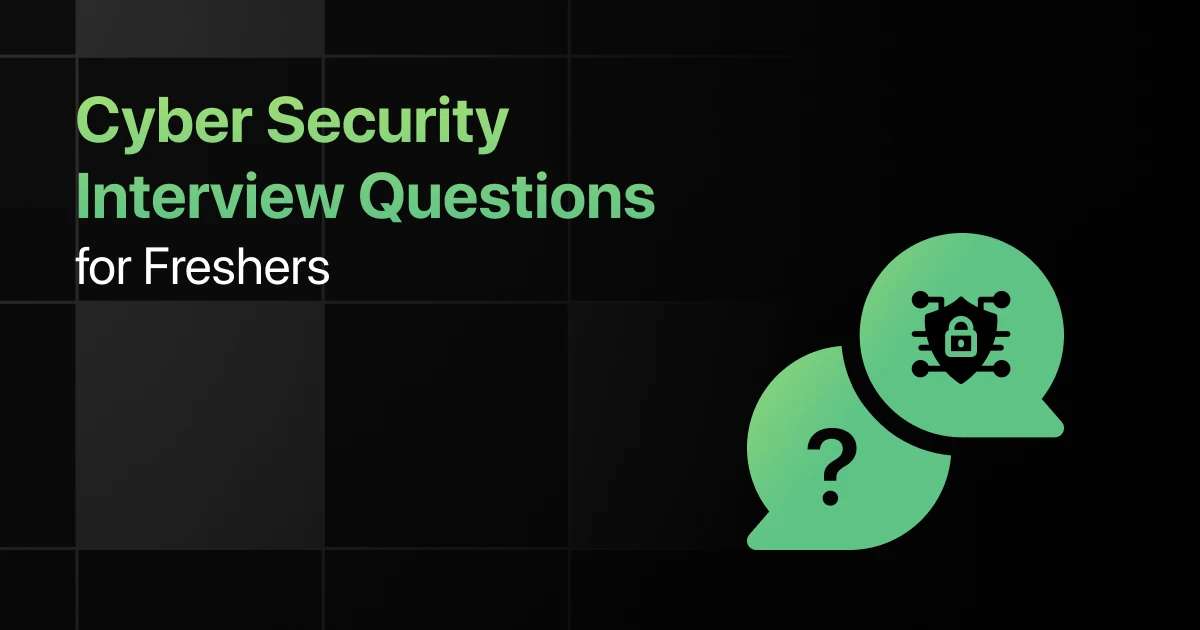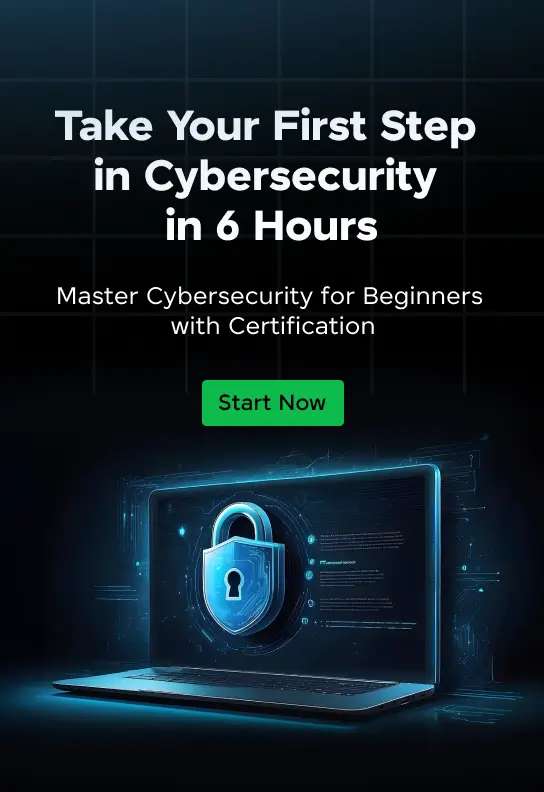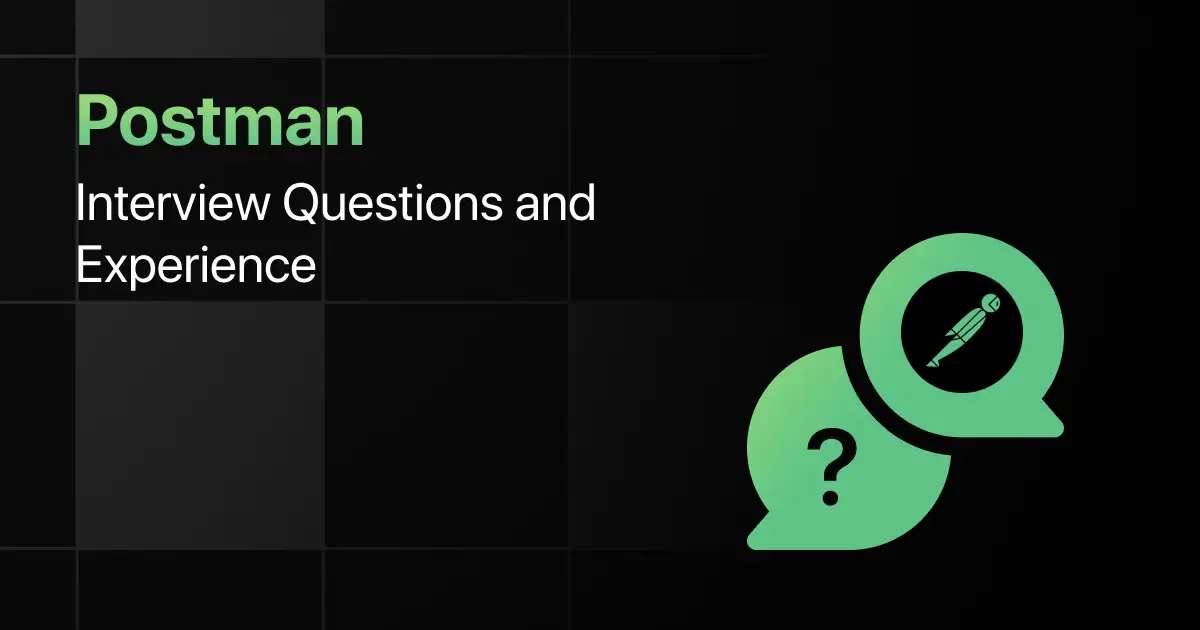Top Cyber Security Interview Questions for Freshers

Are you preparing for your first Cyber Security interview and wondering what questions you might face?
Understanding the key Cyber Security interview questions for freshers can give you more clarity.
With this guide, you’ll be well-prepared to tackle these cybersecurity interview questions and answers for freshers and make a strong impression in your interview.
Practice Cyber Security Interview Questions and Answers
Below are the top 50 Cyber Security interview questions for freshers with answers:
1. What is the CIA triad in cybersecurity?
Answer:
The CIA triad consists of three core principles: Confidentiality, Integrity, and Availability.
Confidentiality ensures that sensitive information is accessed only by authorized individuals. Integrity guarantees that data is accurate and unaltered, while availability ensures that information and resources are accessible to authorized users when needed.
2. What is a DDoS attack, and how can it be mitigated?
Answer:
A Distributed Denial of Service (DDoS) attack aims to overwhelm a target’s resources, making it unavailable to legitimate users.
Mitigation strategies include using web application firewalls (WAFs), traffic analysis, rate limiting, and deploying DDoS protection services that absorb and filter malicious traffic before it reaches the target.
3. Explain the concept of phishing and how to recognize it.
Answer:
Phishing is a cyber-attack where attackers impersonate legitimate organizations to trick individuals into revealing sensitive information, such as passwords or credit card numbers.
Recognizing phishing attempts often involves looking for signs like generic greetings, suspicious URLs, and unexpected attachments or requests for sensitive information.
4. What is the purpose of firewalls in a network?
Answer:
Firewalls serve as a security barrier that monitors and controls incoming and outgoing network traffic based on predetermined security rules.
They help protect networks from unauthorized access and potential threats by filtering traffic, allowing only legitimate traffic while blocking malicious attempts.
5. Describe the concept of a VPN and its security benefits.
Answer:
A Virtual Private Network (VPN) creates a secure, encrypted connection over a less secure network, such as the Internet.
Using a VPN enhances security by protecting sensitive data from eavesdropping and allowing users to access resources securely, especially when using public Wi-Fi.
6. What are the key differences between symmetric and asymmetric encryption?
Answer:
Symmetric encryption uses a single key for both encryption and decryption, making it faster but requiring secure key distribution.
Asymmetric encryption uses a pair of keys—public and private—where the public key encrypts data and the private key decrypts it. This method enhances security by eliminating the need for key exchange.
7. Explain what an intrusion detection system (IDS) is.
Answer:
An Intrusion Detection System (IDS) monitors network traffic for suspicious activity and potential threats, alerting administrators when such activity is detected.
IDS can be classified as host-based or network-based, providing insights into security breaches and helping organizations respond to incidents effectively.
8. What is the importance of patch management in cybersecurity?
Answer:
Patch management involves regularly updating software and systems to fix vulnerabilities and improve security.
Effective patch management reduces the risk of exploitation by addressing known security flaws, ensuring that systems remain resilient against emerging threats.
9. Describe the role of social engineering in cybersecurity attacks.
Answer:
Social engineering involves manipulating individuals into divulging confidential information or performing actions that compromise security.
Common tactics include pretexting, baiting, and tailgating, emphasizing the need for user education and awareness to mitigate such risks.
10. What is multi-factor authentication (MFA), and why is it important?
Answer:
Multi-factor authentication (MFA) requires users to provide two or more verification factors to gain access to an account or system.
MFA enhances security by adding layers of protection, making it significantly harder for unauthorized users to gain access, even if they obtain a password.
11. What is a security policy, and what should it include?
Answer:
A security policy is a formal document outlining an organization’s approach to managing its information security.
It should include guidelines on acceptable use, access controls, incident response, data protection measures, and employee responsibilities, ensuring all stakeholders understand their roles in maintaining security.
12. How does a man-in-the-middle attack work?
Answer:
A man-in-the-middle (MitM) attack occurs when an attacker intercepts communication between two parties without their knowledge.
This can allow the attacker to eavesdrop, alter communications, or steal sensitive information, highlighting the importance of encryption to secure data in transit.
13. Explain the principle of least privilege.
Answer:
The principle of least privilege dictates that users should have the minimum level of access necessary to perform their job functions.
Implementing this principle reduces the attack surface and limits the potential damage from compromised accounts or insider threats.
14. What are the common types of malware?
Answer:
Common types of malware include viruses, worms, Trojans, ransomware, and spyware.
Each type has distinct characteristics and methods of infection, emphasizing the need for robust security measures to detect and mitigate malware threats.
15. Describe the concept of network segmentation.
Answer:
Network segmentation involves dividing a network into smaller, isolated segments to improve performance and enhance security.
By limiting access between segments, organizations can contain potential breaches and reduce the risk of lateral movement by attackers within the network.
16. What is a zero-day vulnerability?
Answer:
A zero-day vulnerability is a security flaw that is unknown to the software vendor and has no available patch or fix.
These vulnerabilities pose significant risks as attackers can exploit them before the vendor becomes aware and develops a remedy.
17. How do SSL and TLS enhance web security?
Answer:
SSL (Secure Sockets Layer) and TLS (Transport Layer Security) are cryptographic protocols that provide secure communication over the Internet.
They encrypt data transmitted between clients and servers, ensuring confidentiality and integrity, which is essential for protecting sensitive information during online transactions.
18. What is a security incident response plan (IRP)?
Answer:
A security incident response plan (IRP) is a documented strategy outlining how an organization will respond to security incidents.
It typically includes roles and responsibilities, incident identification, containment, eradication, recovery procedures, and post-incident analysis to improve future responses.
19. What are insider threats, and how can they be mitigated?
Answer:
Insider threats are security risks that originate from within the organization, often from employees or contractors who misuse their access.
Mitigation strategies include monitoring user activity, implementing strict access controls, providing security training, and fostering a culture of transparency to reduce the risk of insider incidents.
20. How can organizations secure their cloud environments?
Answer:
Organizations can secure their cloud environments by implementing strong access controls, data encryption, and regular security assessments.
Using tools like cloud security posture management (CSPM) helps identify misconfigurations, while adhering to compliance standards ensures data protection in cloud environments.
21. What is a phishing simulation, and why is it beneficial?
Answer:
A phishing simulation is a training exercise where employees receive simulated phishing emails to test their awareness and response.
These simulations help organizations identify vulnerabilities, educate employees about recognizing phishing attempts, and reinforce best practices for email security.
22. Describe the difference between a vulnerability assessment and a penetration test.
Answer:
A vulnerability assessment identifies and evaluates security weaknesses in systems and applications, while a penetration test simulates an attack to exploit those vulnerabilities.
While vulnerability assessments focus on discovery and reporting, penetration tests provide insights into the actual risk posed by vulnerabilities and the effectiveness of existing security measures.
23. How can you protect sensitive data at rest?
Answer:
Protecting sensitive data at rest involves using encryption, access controls, and regular audits to safeguard stored information.
Implementing strong access policies and data classification helps ensure that only authorized users can access sensitive data, reducing the risk of data breaches.
24. What is the purpose of a digital certificate?
Answer:
A digital certificate verifies the identity of an entity, ensuring that public keys belong to the individual or organization they claim to represent.
Digital certificates are essential for establishing trust in electronic communications and are commonly used in SSL/TLS protocols for secure web browsing.
25. How does a security information and event management (SIEM) system work?
Answer:
A SIEM system collects and analyzes security data from across an organization’s infrastructure to identify potential threats and incidents.
By aggregating logs, events, and alerts, SIEM systems provide centralized visibility, enabling real-time monitoring and incident response capabilities.
26. What are the steps involved in the cybersecurity risk management process?
Answer:
The cybersecurity risk management process typically includes identifying assets, assessing threats and vulnerabilities, implementing controls, and monitoring for ongoing risks.
Regularly reviewing and updating risk assessments ensures organizations remain aware of emerging threats and can adapt their security strategies accordingly.
27. What is ransomware, and how can organizations defend against it?
Answer:
Ransomware is a type of malware that encrypts files on a victim’s system, demanding payment for the decryption key.
Organizations can defend against ransomware by implementing robust backup solutions, user education, and endpoint protection to detect and mitigate attacks before they can cause damage.
28. How can you securely dispose of sensitive data?
Answer:
Securely disposing of sensitive data involves using methods like data wiping, physical destruction of storage devices, or using certified data destruction services.
These methods ensure that data cannot be recovered or accessed by unauthorized individuals, maintaining confidentiality and compliance with regulations.
29. What is the role of threat intelligence in cybersecurity?
Answer:
Threat intelligence involves gathering and analyzing information about current and emerging threats to inform security decisions and strategies.
By leveraging threat intelligence, organizations can proactively defend against potential attacks, understand attacker behavior, and improve incident response efforts.
30. Describe what a honeypot is in cybersecurity.
Answer:
A honeypot is a decoy system or application designed to attract and deceive attackers, allowing organizations to study attack methods and gather intelligence.
By analyzing the interactions with honeypots, security teams can enhance their defenses and understand threat landscapes better.
31. What is the importance of security awareness training for employees?
Answer:
Security awareness training educates employees about cybersecurity threats, best practices, and their roles in protecting organizational assets.
Effective training reduces the risk of human error, which is often a significant factor in security breaches, by fostering a security-conscious culture within the organization.
32. How does encryption protect data in transit?
Answer:
Encryption protects data in transit by converting it into a scrambled format that can only be deciphered by authorized parties with the correct keys.
This ensures that even if the data is intercepted during transmission, it remains unreadable and secure from unauthorized access.
33. What is a botnet, and how can it be used in attacks?
Answer:
A botnet is a network of compromised computers or devices controlled by an attacker, often used to launch coordinated attacks, such as DDoS attacks.
Attackers leverage botnets to amplify their attack capabilities, making it difficult for targeted systems to defend against overwhelming traffic.
34. Explain the concept of zero trust security.
Answer:
Zero trust security is a model that assumes no user or device, whether inside or outside the network, should be trusted by default.
This approach requires continuous verification of identities and device integrity, limiting access to resources based on strict identity and context checks.
35. How can organizations implement effective access controls?
Answer:
Organizations can implement effective access controls by defining user roles, applying the principle of least privilege, and using multi-factor authentication.
Regularly reviewing and updating access permissions ensures that users only have the access necessary for their job functions, reducing the risk of unauthorized access.
36. What is an SQL injection attack?
Answer:
An SQL injection attack occurs when an attacker inserts malicious SQL code into a web application’s input fields to manipulate the database.
To defend against SQL injection, developers should use parameterized queries and prepared statements to sanitize inputs and prevent unauthorized database access.
37. Describe the role of incident response teams (IRT).
Answer:
Incident response teams (IRT) are specialized groups within an organization responsible for detecting, responding to, and recovering from security incidents.
Their roles include assessing incidents, coordinating response efforts, and performing post-incident analysis to improve future security practices.
38. What are some common methods of data exfiltration?
Answer:
Common methods of data exfiltration include using malware, unauthorized cloud storage, physical devices, and social engineering techniques.
Organizations must implement monitoring and data loss prevention (DLP) solutions to detect and prevent unauthorized data transfers.
39. How can network monitoring help improve cybersecurity?
Answer:
Network monitoring helps improve cybersecurity by providing real-time visibility into network traffic, allowing for the detection of unusual patterns and potential threats.
By analyzing logs and alerts, security teams can respond quickly to incidents and identify vulnerabilities before they can be exploited.
40. What is the purpose of penetration testing?
Answer:
Penetration testing simulates cyber-attacks on systems and applications to identify vulnerabilities before they can be exploited by malicious actors.
The results help organizations strengthen their security posture by addressing identified weaknesses and validating the effectiveness of existing security controls.
41. What is two-factor authentication (2FA), and how does it enhance security?
Answer:
Two-factor authentication (2FA) requires users to provide two forms of verification—something they know (like a password) and something they have (like a mobile device).
This added layer of security significantly reduces the risk of unauthorized access, even if passwords are compromised.
42. How do security audits contribute to an organization’s cybersecurity posture?
Answer:
Security audits evaluate an organization’s security policies, practices, and controls to identify weaknesses and ensure compliance with regulations.
Regular audits help organizations stay ahead of potential threats and enhance their security measures by addressing gaps and improving overall practices.
43. What is the role of a Chief Information Security Officer (CISO)?
Answer:
The Chief Information Security Officer (CISO) is responsible for overseeing an organization’s information security strategy, policies, and programs.
The CISO plays a critical role in risk management, incident response, and ensuring compliance with security regulations and standards.
44. What is the difference between black hat, white hat, and gray hat hackers?
Answer:
Black hat hackers exploit vulnerabilities for malicious purposes, white hat hackers use their skills to improve security, and gray hat hackers operate between the two, sometimes testing systems without permission.
Understanding these distinctions is crucial for developing effective security strategies and fostering responsible hacking practices.
45. How can mobile devices be secured in the workplace?
Answer:
Mobile devices can be secured in the workplace by implementing mobile device management (MDM) solutions, enforcing strong authentication measures, and ensuring data encryption.
Regularly updating devices and educating employees about mobile security best practices also play a vital role in protecting sensitive information.
46. What are the potential risks of using public Wi-Fi networks?
Answer:
Public Wi-Fi networks pose risks such as data interception, man-in-the-middle attacks, and unauthorized access to devices connected to the network.
Using a VPN, avoiding sensitive transactions, and ensuring devices have up-to-date security patches can mitigate these risks.
47. How does social media pose security risks to organizations?
Answer:
Social media can pose security risks through data leaks, social engineering attacks, and the potential for phishing attempts targeting employees.
Organizations should implement social media policies and training to mitigate these risks and educate employees about the dangers of oversharing information.
48. What is the importance of data classification in cybersecurity?
Answer:
Data classification helps organizations categorize data based on its sensitivity and criticality, enabling tailored security measures and compliance efforts.
By classifying data, organizations can implement appropriate controls to protect sensitive information and streamline incident response processes.
49. How can an organization create a culture of security awareness?
Answer:
Creating a culture of security awareness involves regular training, communication about security policies, and encouraging employees to report suspicious activities.
Involving employees in security discussions and recognizing their efforts in maintaining security can foster a proactive security mindset throughout the organization.
50. What are the key components of a cybersecurity framework?
Answer:
A cybersecurity framework typically includes components such as risk assessment, incident response planning, access controls, security monitoring, and employee training.
These components work together to create a comprehensive approach to managing and mitigating cybersecurity risks, ensuring organizations can effectively protect their assets.
Final Words
Getting ready for an interview can feel overwhelming, but going through these Cyber Security fresher interview questions can help you feel more confident.
With the right preparation, you’ll ace your Cyber Security interview but don’t forget to practice key topics like network security, encryption, vulnerability assessments, and incident response-related interview questions too.
Explore More Cyber Security Resources
- Cyber Security Websites
- Cyber Security Apps
- Cyber Security YouTube Channels
- Cyber Security Project Ideas
Explore More Interview Questions
- Python
- Java
- SQL
- React
- JavaScript
- C Programming
- HTML
- CSS
- Angular
- C++
- Spring Boot
- Node JS
- Excel
- C#
- DBMS
- PHP
- Linux
- Operating System
- MySQL
- Spring
- Flutter
- MongoDB
- Django
- React Native
- jQuery
- Bootstrap
- Embedded C
- DSA
- R Programming
- Hadoop
- .NET
- Power BI
- ASP.NET
- ASP.NET MVC
- Android
- Tableau
- MVC
- WordPress
- TypeScript
- Spark
- Kotlin
- Swift
- Golang
- Shell Scripting
- iOS
- Spring MVC
- Next JS
- AWS
- Kubernetes
- Docker
FAQs
Common Cyber Security interview questions for freshers include topics like explaining encryption and hashing, describing types of cyberattacks (e.g., phishing, DDoS), understanding firewalls, and VPNs, and discussing OWASP Top 10 vulnerabilities.
Freshers should focus on core topics like network security, cryptography, malware analysis, security protocols (SSL/TLS), penetration testing, and common vulnerabilities (e.g., SQL injection, XSS).
Freshers should gain hands-on experience through labs and simulations, practice with security tools (like Wireshark or Metasploit), and understand real-world security incidents.
Reviewing incident response, defense mechanisms, and secure coding practices is essential.
For coding-related questions, break the problem down, apply secure coding principles, and focus on preventing vulnerabilities such as buffer overflows and input validation issues.
Yes, freshers should prepare for advanced topics like ethical hacking, digital forensics, and threat hunting.
Related Posts


Paytm Interview Questions and Experience
Preparing for a Paytm interview requires a clear understanding of the company’s hiring process, the type of questions asked, and …
Warning: Undefined variable $post_id in /var/www/wordpress/wp-content/themes/placementpreparation/template-parts/popup-zenlite.php on line 1050








